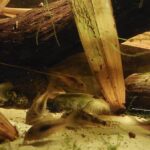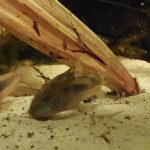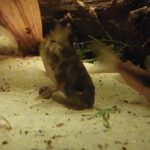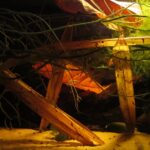Corydoras aeneus in pond, Los Tres Gigantes, Paraguay
_st place in Biotope Aquarium Design Contest 2022

Volume of your aquarium: 160 Liter
Dimensions of your aquarium: 100 B / 40 H / 40 T in cm
List of fishes: 29x Corydoras aeneus Gill, 1858, 7x Corydoras paleatus Jenyns, 1842
Physidae: Melanoides tuberculata
List of plants: Epipremnum aureum, Hydropogonella gymnostoma
Description of Decorations and Substrate: My biotope shows a pond with a weak current. Hardwood (washed up on Lake Constance), grapevine (dried for years) and tropical foliage & bark from Chamaedorea, foliage guava and hura crepitans lie on beige sand or hang in the root. Mulm is not removed. Queen moss and living monstra root shade the biotope by about 50%. Since Corydoras are intestinal breathers, I’m assuming that they also populate ponds as a niche habitat during the dry season.
Description of Equipment: Lighting: CASALUX LED warm white (2,700 K) 12 hours
Filter: Mobile HMF reactor JuniorBlackLine J40-2-PUMP 200l/h, No heater
Water Parameters: PH 7,5, GH 11,6, KH 11,0, Nitrite 0, Temperatur, Winter ca. 22 Grad, Sommer bis 26 Grad
Additional Info: Partial water change about 20% every 14 days without ground care, lighting on the right side of the aquarium warm white, resulting in shadows on the left and HMF “invisible” in the evening.
Epipremnum aureum root has been in the tank for over 8 years.
Age of the Corydoras (owned since 8/2012) between 9 1/2 years and 4 weeks.
Snails were introduced by earlier aquatic plants and here they are.
Aquarium video:
Description of the Area Surrounding the Biotope:
Paraguayan Pantanal RESEARCH STATION “LOS TRES GIGANTES” 20° 11′ 18.69 “S 58° 9′ 25.574” W
is located in the Río Negro National Park and is part of the Pantanal region in the largest inland wetland in the world. Bahía Negra is the nearest town about 40km away.
In the Paraguayan Pantanal, during the dry season, from April to October, the water level drops and forms individual pools where there is still water exchange and the associated temperature fluctuations are weakened. Chamaedorea is very common here, provides shade and high grass, by feeding the spring, which is created by seeping in from the Rio Negro.
Description of the Underwater Landscape of the Biotope: The pool lasts a few months, with leaves and wood covered with moss on the 6) loamy sandy bottom. In the rainy season, flooding occurs and some Corydoras move. Mailed catfish are often only 7) seasonal catfish in nature.
Description of the Habitat Parameters: PH 5.0 and 7.5, GH 6.0 and 11.6, KH 11.0, nitrites 0
Temperature between 20 and 28 degrees
Water is mostly clear. In the dry season, with less water exchange, it can turn brownish through the foliage.
List of Fishes and Invertebrates Occurring in the Nature Biotope: 4 / 8 ) Corydoras aeneus Gill, 1858,
Corydoras paleatus Jenyns, 1842
List of Plants Found in the Nature Biotope: Hydropogonella gymnostoma
Threats to the Ecology of the Biotope: The Pantanal area has been threatened by a major fire in recent years, with water exchange between wet and dry seasons becoming more erratic. Global warming is also noticeable here.
5) Fortunately, Paraguay has not yet been fully explored in terms of underwater biodiversity, as there is a lot of private property. Entering the areas therefore requires permits. Individual owners conserve nature on their land based on Campania Nature Conservation Agency. Others cut down and grow soy for Europe or keep large herds of cattle.
Sources of Information:
1) https://www.aquasabi.de/Hydropogonella-gymnostoma-Pad-5-x-5-cm
3) https://www.youtube.com/watch?v=Z62flR8Is7M
4) Erik Schiller per e-mail
5) https://www.youtube.com/watch?v=3maXDaFNceY&list=UUZHuEhmXzuA1iT-zGgKdPKg&index=2
6) https://www.dw.com/de/amazonas-%C3%BCppige-regenw%C3%A4lder-nutzlose-b%C3%B6den/a-50135514
7) https://www.aqualog.de/lexikonkategorie/steckbrief-panzerwelse/
8) http://www.corydorasforum.de/Datenbank/Steckbriefe/co_db_aeneus.html
8) https://www.seriouslyfish.com/





